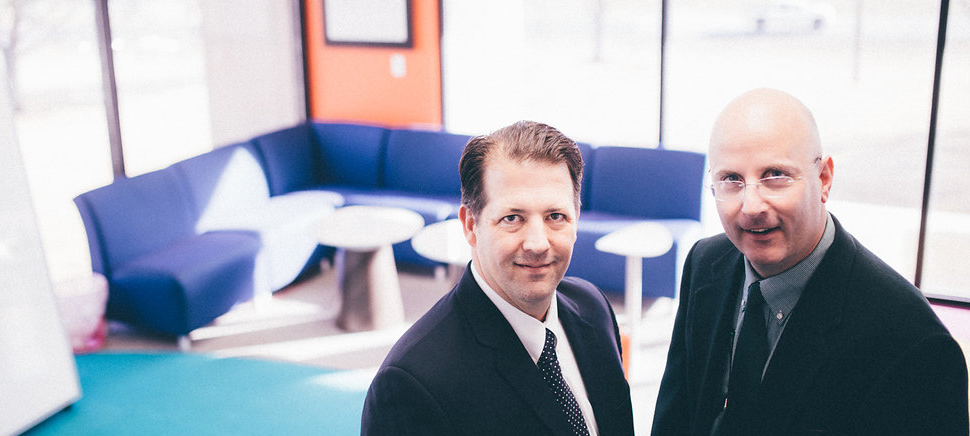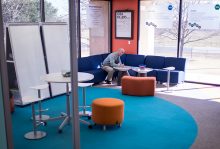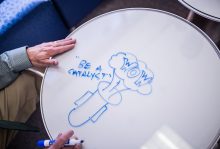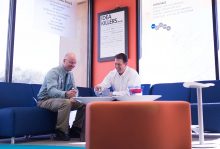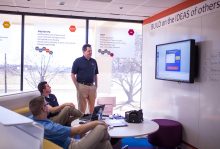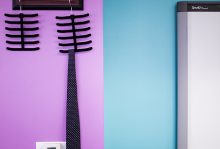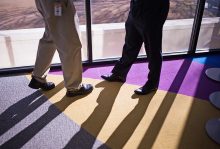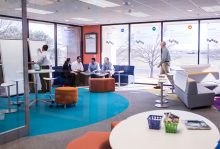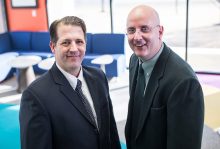A tour of the Peterbilt Motors Company campus in Denton helps dispel any stereotypes about the trucking industry that you might have picked up during a lifetime of visits to truck stops. The manufacturing facility is clean and efficient enough that one corner could be devoted to a showroom housing trucks of the past, present, and future. One of those future models is the Walmart Advanced Vehicle Experience, a prototype for an aerodynamic truck with a hybrid engine and a centered driver’s seat. And the offices include a colorful playroom designed to encourage creativity in all employees.
As one Denton city official said after being shown around the Peterbilt facility, “I realize you guys are more the prototype than the stereotype.” Jan Langelius, a senior project engineer, loves to repeat that quote when hosting visitors, because it shows that “we’re changing people’s perspectives on who we are and what we’re doing,” he says.
“One of the tenets that they have there is ‘Space drives behavior,’” Jan Langelius says. “We knew we needed to enhance our innovative space.”
Those changes can be traced back to 2011, when Langelius was among a group of employees who visited California for a three-day immersion course at IDEO, a design firm with ties to Stanford University’s Hasso Plattner Institute of Design. IDEO’s approach to design “brings together what is desirable from a human point of view with what is technologically feasible and economically viable,” according to its website. Langelius and his colleagues came home inspired by the concept of “human-centered design.”
“One of the tenets that they have there is ‘Space drives behavior,’” Langelius says. “We knew we needed to enhance our innovative space.”
So they created the Light House for Innovation, the aforementioned colorful room that is available to employees from any department. Splashed with hues that include teal, magenta, and yellow, the open space definitely stands out among the sea of gray cubicles that fill the rest of the corporate offices. Naturally, people are drawn to it.
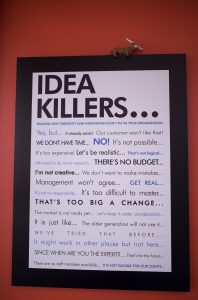
Idea killers at Peterbilt. Photo by James Coreas
“People just wander in, wondering ‘What is going on in there?’” says Wesley Slavin, a Peterbilt marketing manager who also had a hand in the Light House’s creation.
The Light House has no door, and it cannot be reserved, so anybody can walk in at any time. It is equipped with a touch-screen smart board and a television, but it strategically has no landline phones. “We didn’t want it to be just another conference room,” Slavin says.
Not only are employees drawn to the Light House, they can draw on it. Every surface is writable—from the windows to the tabletops—and all of the furniture is movable. There are inspirational posters, including a list of “Idea Killers” such as “That’s too big a change” and “That’s not logical.” It’s all designed to spark brainstorming.
“Let’s make it as easy as possible for them,” Wesley Slavin says, “because everything else they do is really hard.”
Asked to cite specific projects that stemmed from Light House sessions, Langelius and Slavin mentioned the creation of a new 58-inch sleeper box—Peterbilt previously had no happy medium between the cramped 44-inch sleeper and the expansive 72-inch version—and a refreshed interior for the Model 320 truck used mainly by garbage collectors, who have a lot of unique needs thanks to their constant stops and shifts between sitting and standing positions.
“Let’s make it as easy as possible for them,” Slavin says, “because everything else they do is really hard.”
The design phase of the 58-inch sleeper box included working with foam-core prototypes, which were much more modifiable than the clay models used previously. If the piece of foam core representing, say, a microwave oven seemed out of place, then engineers could simply rip it out and stick it somewhere else.
“If the room is shifting mindsets, stimulating creativity, and generating new ideas, these are the behaviors we’re trying to create,” Slavin says.
The Light House inspired the creation of the Peterbilt Empathy Training Experience, aka P.E.T.E, which 200 employees have participated in on a voluntary basis. Designed to generate even more new ideas, the weeklong sessions include spending the night in a sleeper box at a truck stop and interviewing actual truckers while they’re there.
“The idea is, let’s take that customer insight and convert it into product ideas,” Slavin says.
As much as has been accomplished since that 2011 trip to IDEO, and as much as visitors are impressed by all of the creativity happening on the Peterbilt campus, Langelius, Slavin, and their colleagues are not content to rest on their laurels. In fact, the Light House may have a makeover in store.
“This space is due for an iteration,” Langelius says. “We love the behavior it creates, but we want to be sure it evolves.”
For a daily dose of what’s new, now, and next in Dallas-Fort Worth innovation, subscribe to our Dallas Innovates e-newsletter.

